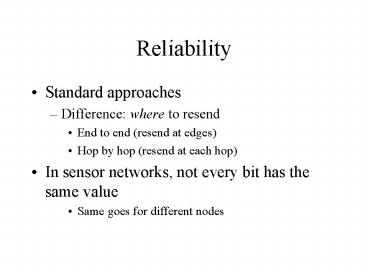Reliability - PowerPoint PPT Presentation
1 / 10
Title:
Reliability
Description:
Hop by hop (resend at each hop) In sensor networks, not every bit has ... Less duplicates. More energy efficient. TinyRNC. more? SMAC. unicast. Energy efficient ... – PowerPoint PPT presentation
Number of Views:51
Avg rating:3.0/5.0
Title: Reliability
1
Reliability
- Standard approaches
- Difference where to resend
- End to end (resend at edges)
- Hop by hop (resend at each hop)
- In sensor networks, not every bit has the same
value - Same goes for different nodes
2
Reliability (contd)
- Proposed approach Information-driven reliability
- When
- Is latency a concern?
- Is the information time-sensitive?
- What
- Is the information critical?
- Can the application operate fairly correctly
without it? - Where
- Which nodes along the path should retransmit?
- Who
- Clusterheads, aggregators and other important
nodes in the path can request retransmission from
neighbors - Receiver-initiated reliability
3
First steps JR deployment
- Two major message types
- Control
- Requirement Low latency
- Data
- Requirement Energy efficiency
4
Control messages Reliability
- What we have
- RNC
- broadcast (or 1-hop multicast)
- Relatively low latency
- (at its current state) Energy inefficient
- Needs to be improved
- Less duplicates
- More energy efficient
- TinyRNC
- more?
- SMAC
- unicast
- Energy efficient
- More latency? (sleep cycles)
5
Data messages Reliability
- What we want
- Reliable low energy data
- Receiver driven
- Receiver(s) control sources
- How far along the tree do we go?
- All the way (end 2 end)?
- 1 hop?
- some hops until an aggregator is reached?
- Policy driven selective NACK
6
Different reliability policies
- Time/space width matrix
- Narrow time-narrow space
- Standard reliability (end to end)
- Narrow time-wide space
- Reverse anycast Any one of N spacially
distributed nodes packets reliabily gets to
destination - Wide time-narrow space
- Statistical reliabilty some samples out of the
data series (or some messages in general)
reliably get to destination - Wide time-wide space
- No reliability best effort
7
Applications and Reliability reqs
- Localization-tracking (Hanbio)
- TCP-like
- Mulihop
- 100 delivery (all data)
- Microclimate monitoring (JR)
- End-to-end through hop-by-hop (link-level
retransmissions) - 100 delivery
- Spatial aggregation (Simon)
- Link-level (single-hop extended to multihop)
- Estimation/error driven
- Combination of information importance and energy
cost - Not necessarily 100
8
Thoughts
- Application-specific reliability
- Application drives the reliability model
- Information importance only available through app
- Link quality determines energy cost
- Can be provided by a linkstats model
- Optimization problem (?)
- Given data importance cost, determine optimal
retransmission request
9
Data importance
- If the spatial frequency of the physical
phenomenon is known, things are relatively easy - Dense deployment, redundant information
- What if it isnt?
- Entropy is one way to characterise importance
(useful information carried per packet) - Completely application dependent
- Any other way?
- What is known about the phenomenon? What needs to
be known? - Continuous refresh mode Data importance (and
link quality) must be continuously computed for
best accuracy
10
A slightly different approach
- Treat the retransmission selection problem as a
data generation problem - Deepaks suggestion
- Selects which nodes should generate data, out of
those that are retransmission candidates - For Deepaks application, can potentially use the
same metric































